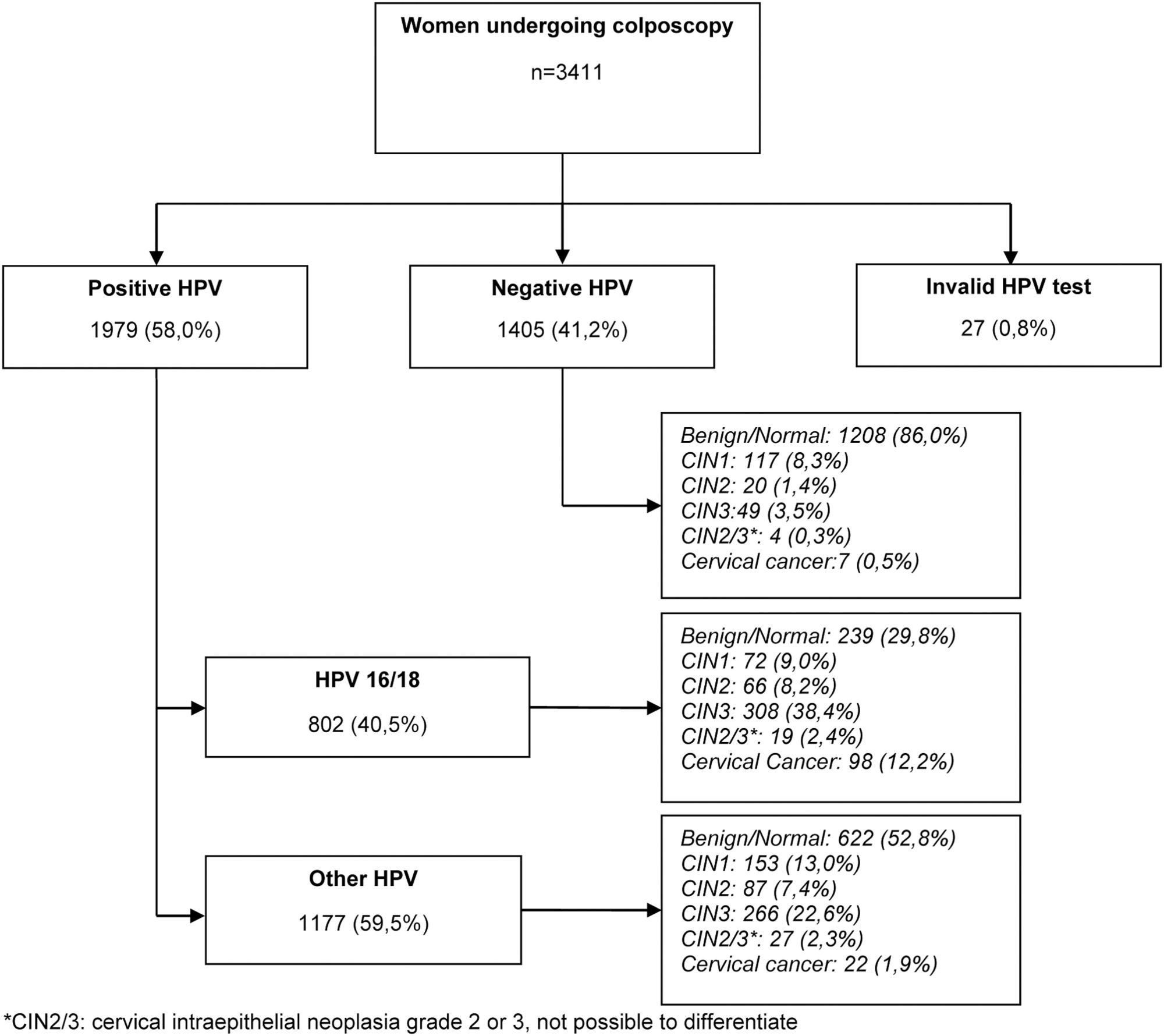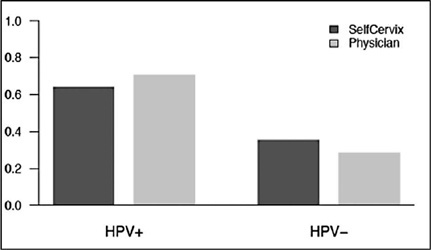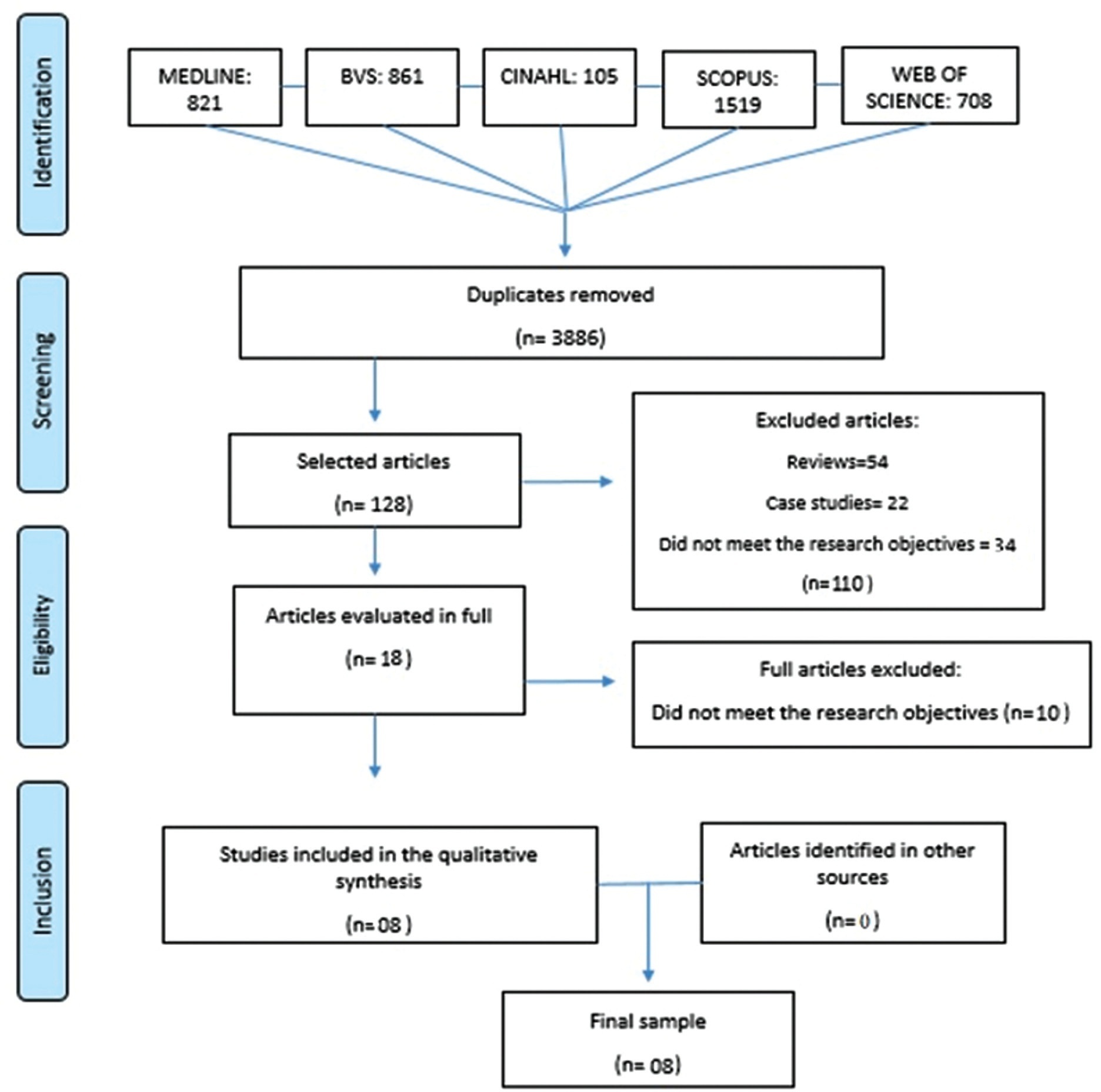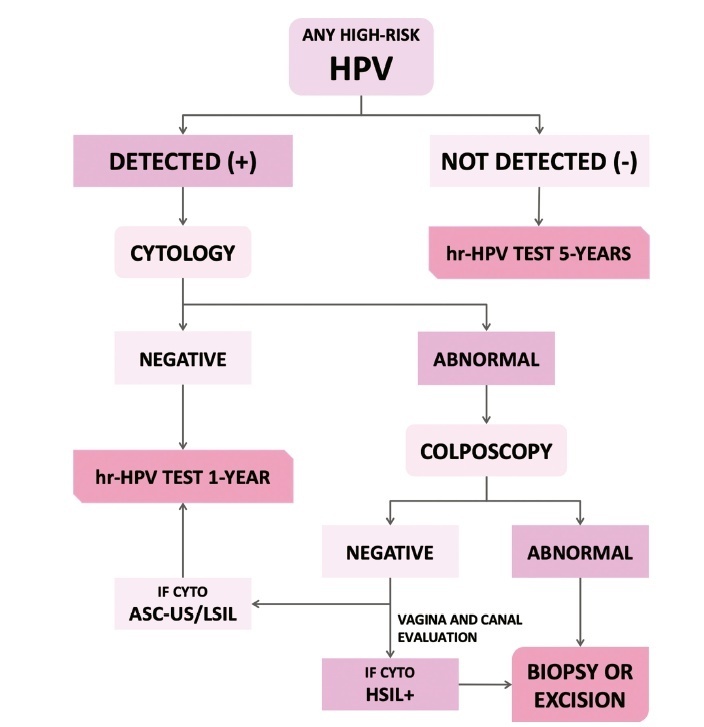Summary
Rev Bras Ginecol Obstet. 2023;45(12):790-795
To compare cytological and histological results from women > 64 years old who followed the Brazilian national cervical cancer screening guidelines with those who did not.
The present observational retrospective study analyzed 207 abnormal cervical smear results from women > 64 years old in a mid-sized city in Brazil over 14 years. All results were reported according to the Bethesda System. The women were divided into those who followed the screening guidelines and those who did not.
Atypical squamous cells of undetermined significance and low-grade squamous intraepithelial lesion cytology results were found in 128 (62.2%) cases. Of these, 112 (87.5%) had repeated cytology with positive results. The other 79 (38.1%) with abnormal results should have been referred to colposcopy and biopsy. Out of 41 (51.9%) biopsied women, 23 (29.1%) had a confirmed diagnosis of neoplasia or precursor lesion. In contrast, among the 78 (37.7%) biopsied patients, 40 (51.3%) followed the guideline recommendations, with 9 (22.5%) positive biopsies. Of the 38 (48.7%) women who did not follow the guidelines, there were 24 (63.1%) positive results. Women who did not follow the guidelines demonstrated higher chances of cancer and precursor lesions (odds ratio [OR]: 5.904; 95% confidence interval [CI]: 2.188–15.932; p = 0.0002).
Women > 64 years old who did not follow the national screening protocol showed significant differences in the frequency of abnormal results and severity of diagnosis compared with those who followed the protocol.
Summary
Rev Bras Ginecol Obstet. 2023;45(11):689-698
The present study aims to establish a risk profile for high-grade cervical lesions and cervical cancer (CIN2 + ) in women undergoing colposcopy at the Hospital do Câncer de Barretos, through the analysis of Human Papillomavirus (HPV) infection, cervical cytology, and patient's age.
Retrospective cross-sectional study based on a computerized database of women aged ≥ 18 years old who underwent colposcopy at the Prevention Department of the Hospital do Câncer de Barretos from 2017 to 2019.
A total of 3,411 women were included, 58.0% were positive for high-risk-HPV test, with a higher prevalence of CIN2+ for HPV16 (30.3%) and other HPV (45.0%). Cytological findings that suggest invasive cervical cancer (squamous cells or adenocarcinoma), regardless of the status of HPV test, showed 100% diagnosis of CIN2 + , while atypias that suggest high-grade lesions, HSIL and ASC-H, positive for HPV test, showed in 86 and 55.2%, respectively, diagnosis of CIN2 + . ASC-H cytological results among women aged > 40 years old and negative HPV were mainly associated with benign findings. We observed that ≤ CIN1 has a higher prevalence among older women with negative HPV, while for high-grade lesions there is an increase among young women HPV16- and/or 18-positive. In cancer diagnosis, we observed a predominance of HPV 16/18 regardless of the age group.
The highest risks of precursor lesions and cervical cancer were found among women with positive HPV 16/18 tests and severe cytological atypia in population screening tests. In addition, cytological findings of ASC-H HPV negative in women > 40 years old usually represent benign findings in histological investigation.

Summary
Rev Bras Ginecol Obstet. 2023;45(5):235-241
To evaluate the accuracy and patient acceptability toward self-sampling using a new device - SelfCervix® - for detecting HPV-DNA.
A total of 73 women aged 25–65 who underwent regular cervical cancer screening from March to October 2016 were included. Women performed self-sampling followed by a physician-sampling, and the samples were analyzed for HPV-DNA. After that, patients were surveyed about their acceptability of self-sampling.
HPV-DNA detection rate of self-sampling presented high accuracy and was similar to physician-collection. Sixty-four (87.7%) patients answered the acceptability survey. Most patients (89%) considered the self-sampling comfortable, and 82.5% preferred self-sampling to physician-sampling. The reasons cited were time-saving and convenience. Fifty-one (79.7%) reported that they would recommend self-sampling.
Self-sampling using the new Brazilian device SelfCervix® is not inferior in HPV-DNA detection rate compared with physician-collection, and patients are supportive of the method. Therefore, it might be an option to reach under-screened populations in Brazil.

Summary
Rev Bras Ginecol Obstet. 2023;45(4):201-206
To evaluate recurrence rates and risk factors among women with stage IA1 cervical cancer without lymph vascular space invasion managed conservatively.
retrospective review of women with stage IA1 squamous cervical cancer who underwent cold knife cone or loop electrosurgical excision procedure, between 1994 and 2015, at a gynecologic oncology center in Southern Brazil. Age at diagnosis, pre-conization findings, conization method, margin status, residual disease, recurrence and survival rates were collected and analyzed.
26 women diagnosed with stage IA1 squamous cervical cancer without lymphovascular space invasion underwent conservative management and had at least 12 months follow-up. The mean follow-up was 44.6 months. The mean age at diagnosis was 40.9 years. Median first intercourse occurred at age 16 years, 11.5% were nulliparous and 30.8% were current or past tobacco smokers. There was one Human immunodeficiency virus positive patient diagnosed with cervical intraepithelial neoplasia grade 2 at 30 months after surgery. However, there were no patients diagnosed with recurrent invasive cervical cancer and there were no deaths due to cervical cancer or other causes in the cohort.
Excellent outcomes were noted in women with stage IA1 cervical cancer without lymphovascular space invasion and with negative margins who were managed conservatively, even in a developing country.
Summary
Rev Bras Ginecol Obstet. 2022;44(8):790-796
This systematic review aims at describing the prevalence of urinary and sexual symptoms among women who underwent a hysterectomy for cervical cancer.
A systematic search in six electronic databases was performed, in September 2019, by two researchers. The text search was limited to the investigation of prevalence or occurrence of lower urinary tract symptoms (LUTS) and sexual dysfunctions in women who underwent a hysterectomy for cervical cancer. For search strategies, specific combinations of terms were used.
A total of 8 studies, published between 2010 and 2018, were included in the sample. The average age of the participants ranged from 40 to 56 years, and the dysfunctions predominantly investigated in the articles were urinary symptoms (n= 8). The rates of urinary incontinence due to radical abdominal hysterectomy ranged from 7 to 31%. The same dysfunction related to laparoscopic radical hysterectomy varied from 25 to 35% and to laparoscopic nerve sparing radical hysterectomy varied from 25 to 47%. Nocturia ranged from 13%, before treatment, to 30%, after radical hysterectomy. The prevalence rates of dyspareunia related to laparoscopic radical hysterectomy and laparoscopic nerve sparing radical hysterectomy ranged from 5 to 16% and 7 to 19% respectively. The difficulty in having orgasm was related to laparoscopic radical hysterectomy (10 to 14%) and laparoscopic nerve sparing radical hysterectomy (9 to 19%).
Urinary and sexual dysfunctions after radical hysterectomy to treat cervical cancer are frequent events. The main reported disorders were urinary incontinence and dyspareunia.

Summary
Rev Bras Ginecol Obstet. 2022;44(3):264-271
The present update is a reassessment of the 2018 ‘Guidelines for HPV-DNA Testing for Cervical Cancer Screening in Brazil’ (Zeferino et al.)9, according to the changes observed in new international guidelines and knowledge updates. The most relevant and recent guidelines were assessed. Questions regarding the clinical practice were formulated, and the answers considered the perspective of the public and private sectors of the Brazilian health system. The review addressed risk-based strategies regarding age to start and stop screening, the use of cytology and colposcopy to support management decisions, treatment, follow-up strategies, and screening in specific groups, including vaccinated women. The update aims to improve the prevention of cervical cancer and to reduce overtreatment and the misuse of HPV testing.

Summary
Rev Bras Ginecol Obstet. 2019;41(5):291-297
To evaluate the level of information possessed by pregnant adolescents regarding the human papillomavirus (HPV).
Descriptive study developed in the adolescent prenatal outpatient clinic of a tertiary hospital fromthe state of São Paulo, Brazil. Data were collected between June and December 2017 following approval from the ethics and research committee (CAAE: 1.887.892/2017). Pregnant adolescents, ≤18 years old, who attended the abovementioned outpatient section, composed the sample. Those diagnosed with a psychiatric disorder and those with hearing or cognitive disabilities were excluded. After acceptance to participate in the present study, the pregnant adolescents signed an Informed Consent Form. Regarding the statistical analysis, the chi-squared test and the Fisher exact test were used.
Regarding the knowledge about HPV, 123 (80.92%) of the participants had already heard about the subject; for 77 (50.66%), their schools had been the source of the information; 101 (66.45%) did not know how they could be infected by the virus. Age variation did not influence their knowledge on how to prevent themselves from HPV (p = 0.2562). The variable vaccine is associated with HPV prevention (p < 0.0001).
The pregnant adolescents composing the sample have shown to have knowledge about HPV. However, they do not prevent themselves from it appropriately, given that little more than half of the sample was vaccinated, had not reported an understanding that the use of preservatives and vaccination are effective means of prevention, and did not correlate HPV with uterine cervical cancer.
Summary
Rev Bras Ginecol Obstet. 2019;41(4):242-248
To analyze the factors associated with health-related quality of life (HRQoL) in women with cervical cancer (CC) in a single center in Rio de Janeiro, state of Rio de Janeiro, Brazil.
A cross-sectional study in women with a diagnosis of CC followed-up in the gynecology outpatient clinic of the Hospital do Câncer II (HCII, in the Portuguese acronym) of the Instituto Nacional de Câncer (INCA, in the Portuguese acronym). The data were collected from March to August 2015. Women with palliative care, communication/cognition difficulty, undergoing simultaneous treatment for other types of cancer, or undergoing chemotherapy and/or radiation therapy were excluded. For the evaluation of the HRQoL, a specific questionnaire for women with CC was used (Functional Assessment of Cancer Therapy - Cervix Cancer [FACT-Cx]). The total score of the questionnaire ranges from 0 to 168, with higher scores indicating a better HRQoL.
A total of 115 women were included in the present study, with a mean age of 52.64 years old (standard deviation [SD] = 12.13). The domains of emotional (16.61; SD = 4.55) and functional well-being (17.63; SD = 6.15) were those which presented the worst scores. The factors that had an association with better HRQoL in women with CC were having a current occupation, a longer time since the treatment and diagnosis, and women who had undergone hysterectomy.
Considering the domains of HRQoL of the women treated for cervical cancer, a better score was observed in the domains of physical and social/family wellbeing. For most domains, better scores were found between those with a current occupation, with a longer time after the diagnosis and treatment, and among those who had undergone a hysterectomy.
Search
Search in:
breast (42) breast cancer (42) breast neoplasms (95) Cesarean section (72) endometriosis (66) infertility (56) Maternal mortality (43) menopause (82) obesity (58) postpartum period (40) pregnancy (225) Pregnancy complications (99) Prenatal care (68) prenatal diagnosis (50) Prevalence (41) Quality of life (51) risk factors (94) ultrasonography (79) urinary incontinence (40) women's health (48)